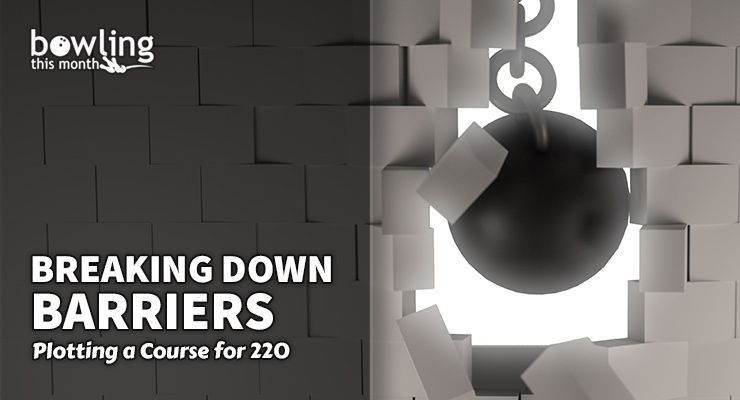Article Contents
- 1. What does a 220 average look like?
- 1.1. Keeping it in perspective
- 2. Improving the spare game
- 3. Getting 20 percent more strikes
- 4. The physical game
- 4.1. Generating enough power
- 4.2. The physical manipulation skill set you need
- 5. Tactical considerations
- 6. Mental game
- 6.1. Blame the lanes
- 7. Closing thoughts
Note: This article is only available to Bowling This Month subscribers.
Let’s talk about averaging 220. For many people, this benchmark represents where the elite league bowlers live. If you are a 160 average bowler, 220 can feel like a whole different planet, but for those bowlers in the 205 average range, it can somehow simultaneously feel both attainable and out of reach.
As with the first two parts of this series (available here and here), we’ll compare the 200 and 220 benchmarks statistically so that we can establish the performance factors that are most important at this stage of development. Then, we’ll look at physical, tactical, and mental considerations to help you on your journey up the bowling food chain.
What does a 220 average look like?
Followers of this series will know what to expect here. Let’s look at a table of the key performance factors for both the 200 average bowler we saw in the first part of this series and a 220 average bowler:
| 200 Average | 220 Average | |
| Strikes | 49.7% | 60.2% |
| Single Pin Spare Conversions | 85.6% | 95.1% |
| Closed Frames | 85.0% | 91.9% |
Wow. Those are some big improvements, with the biggest being in strike percentage, which jumps by 20 percent. In my last article that focused on improving from the 160 to 170 range to over 180, it was easy to pinpoint a couple of key areas of improvement: pocket control and spare shooting. In this case, though, the biggest jump comes from strike percentage. Whenever we talk about striking, there are a lot of factors to consider. But before getting discouraged, remember that the improvements we’ll talk about below are incremental over time, and need to be put into perspective.
Keeping it in perspective
No one is simply going to take a few lessons and see their strike percentage jump by 20 percent. The same goes for buying a new ball. You might get a couple more strikes with that new ball, but not 20 percent more, especially over time when that new ball magic has worn off. The improvement at this stage of the game relies on a synthesis of several elements of the game coming together. We’ll tackle ...
Already a premium member? Click here to log in.


 (Only
(Only 